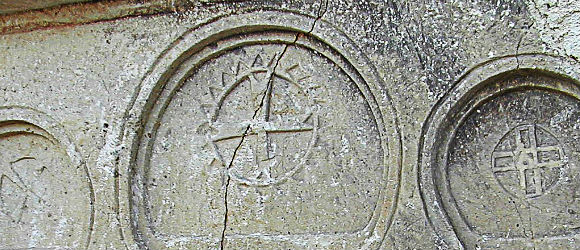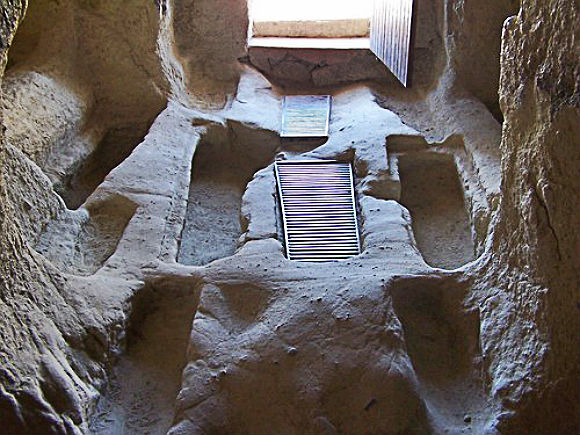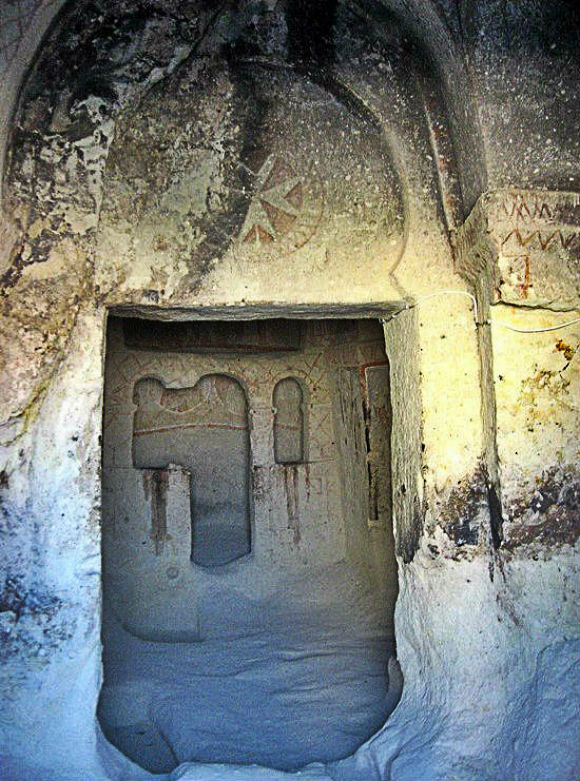Built by a donor named Anna, the Chapel of St. Catherine dates from the 11th century. It has a Greek-cross-shaped nave, with a dome over the center and barrel-vaulted cross arms. The narthex has nine floor tombs and two burial niches.
The bodies of holy martyrs and others now living with Christ, bodies which were His members and temples of the Holy Spirit, which one day are to be raised up by Him and made glorious in everlasting life, are to be venerated by the faithful; God gives men many benefits through them.
Built by a donor named Anna, the Chapel of St. Catherine dates from the 11th century. It has a Greek-cross-shaped nave, with a dome over the center and barrel-vaulted cross arms. The narthex has nine floor tombs and two burial niches.
Situated between the Dark church and the Carikli Church, the Chapel of St.Catherine has a free-cross nave and narthex.
The central bay is covered by a dome and the cross arkms are barrel-vaulted. Its apse is closed by a templon. Tne narthex has nine floor graves and two arcosolia (burial niches).
Only in the nave of the chapel are some decorations with figures. The pendentives are decorated with carvings. The Chapel of St.Catherine, built by a donor named Anna, dates back to the 11th century.
Deesis in the apse with the templon, below are Doctors of the Church (Gregory, Basil the Great and John Chrysostom), on the south wall of the northem arm is St.George, opposite St.Theodore, St.Catherine and other panels of saints.
In the St. Catherine Chapel that is between the Dark Church and the Carikli Church, both the nartex and the naos are free cross planned and central domed; the cross arms are cradle vaulted and absissa temploned. There are nine graves on the nartex floor and two niche graves in the walls.
There are figures only in the naos part of the chapel. The pandantives are covered with the relief geometric ornaments. The St. Catherine Chapel, which is built on the money donated by a person called Anna, and is dated to the 11th century. The Scenes: the Deesis in the temploned abscissa, below this: the church fathers in medallions, (Gregory, Basil, Johm Chrysostom), on the southern wall of the northern cross arm: St George on horse; across from it: St. Theodore, St Catherine and other pictures of the saints.
St. Catherine Chapel,





St. Catherine chapel is situated among the monasteries of Karanlı and of Çarıklı Kilise on the eastern side of the circle of monasteries in Göreme Park. The church includes an image of Saint Catherine with a female donor near the sanctuary, and for this reason it is traditionally associated with Saint Catherine. The donor is named Anna.
The entrance of the church is comprised of a domed cruciform narthex in which previous users have carved burials into the floor. The narthex includes nine floor graves and two arcosolia (burial niches). It is followed by a larger naos of the same shape with a dome and a single apse. The dome rises above a drum of blind niches and rudimentary pilasters. The apse has an elevated templon screen. The central entry of the apse is arched. The screen also includes small lateral arched openings and an open lunette above. An eroded altar was connected to the wall in the apse. The apse includes two carved niches, one to the right of the entry (to the southeast), the other in the apsidal wall (to the north edge).
Chapel of St. Barbara It has a cruciform plan, with two columns. The north, south and west arms of the cruciform are barrel vaulted, and the centre, the east arm, and the east corners are domed. There are a main, central apse and two side apses.
Motifs were painted in red directly onto the rock. The walls and the dome are decorated in a variety of motifs including geometrical patterns, mythological animals and military symbols. The walls also have motifs resembling stonework.
This church dates back to the second half of the 11th century.
On the main apse is Christ Pantocrator, on the north arm are St.George and the Dragon and St Theodore, and on the west arm is St Barbara.
The three figures of triangular shaped trees and the heads of the lances are very hard to explain. It is still not known whether they are described in the “Deesis” or ” Metamorphism”. The cross figures all around this church show us the iconoclassic ideas. The animal figures across from the entrance are mostly for the breaking of the spells.